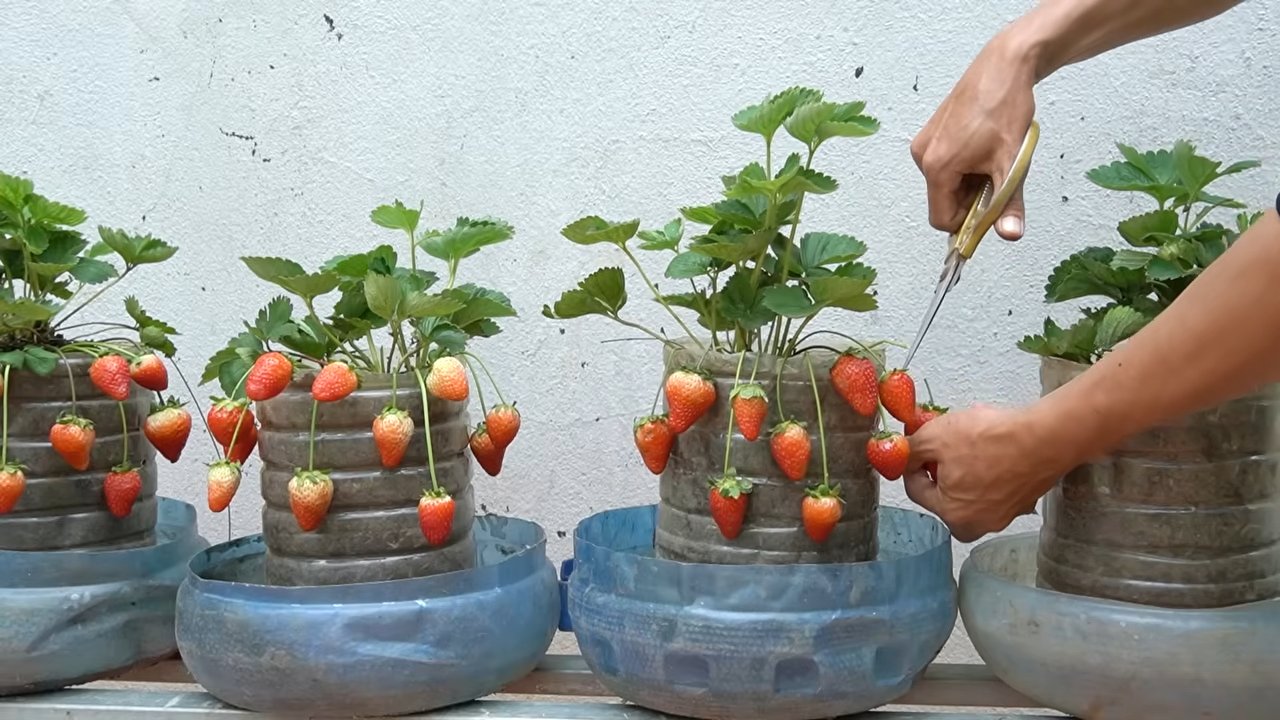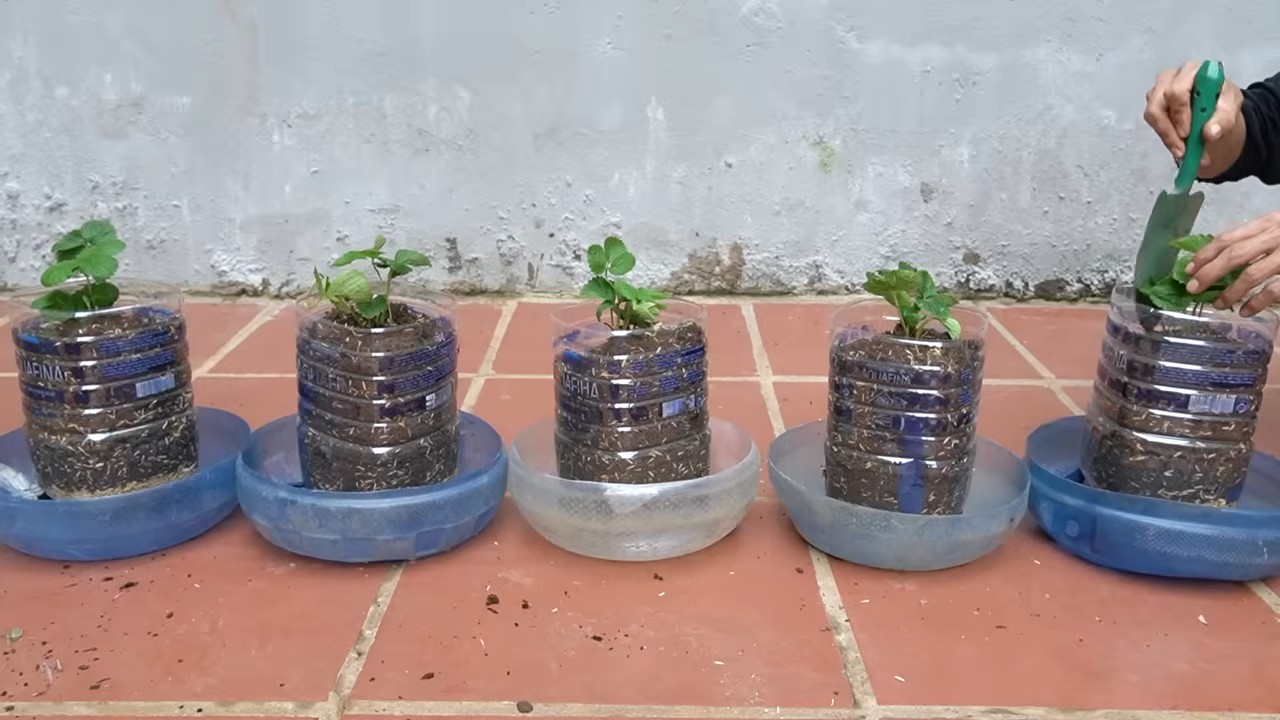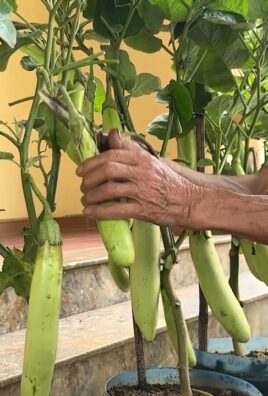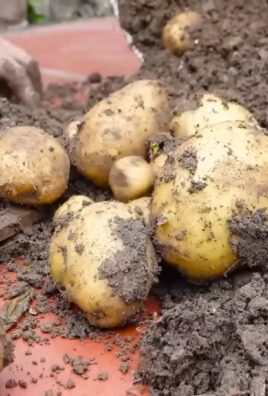Balcony Strawberry Harvesting: Imagine stepping onto your balcony and plucking a sun-ripened, juicy strawberry, bursting with flavor, straight from your own little garden. Sounds like a dream, right? Well, it doesn’t have to be! For centuries, cultivating strawberries has been a cherished practice, from ancient Roman gardens to the sprawling fields of modern farms. But what if you don’t have acres of land? That’s where the magic of balcony gardening comes in!
In this DIY guide, I’m going to share some amazing tricks and hacks to maximize your balcony strawberry harvesting potential. Whether you’re a seasoned gardener or a complete beginner, these tips will help you transform your small outdoor space into a thriving strawberry patch. Think of it as your own personal strawberry oasis, just steps from your living room!
Why is this so important? Because fresh, homegrown strawberries are simply unbeatable. Store-bought berries often lack the intense sweetness and aroma of those grown with love and care. Plus, knowing exactly where your food comes from and how it’s grown gives you peace of mind. So, let’s dive in and unlock the secrets to a bountiful balcony strawberry harvest!

DIY Balcony Strawberry Harvesting System: From Seedling to Sweet Success!
Hey there, fellow balcony gardeners! I’m so excited to share my tried-and-true method for creating a thriving strawberry harvesting system right on your balcony. Forget those expensive store-bought berries – we’re going to grow our own, bursting with flavor and sunshine! This guide will walk you through every step, from choosing the right container to harvesting your delicious bounty. Let’s get started!
Choosing the Right Container and Strawberry Variety
Before we dive into the nitty-gritty, let’s talk about the foundation of our strawberry haven: the container and the strawberry variety. These choices will significantly impact your success, so let’s get them right!
* **Container Considerations:**
* **Size Matters:** Strawberries need room to spread their roots. I recommend containers that are at least 12 inches deep and wide. This gives them enough space to grow and produce a good yield.
* **Drainage is Key:** Excellent drainage is absolutely crucial. Strawberries hate sitting in soggy soil, which can lead to root rot. Make sure your container has plenty of drainage holes. If not, you can easily drill some!
* **Material Options:** You have several options here:
* **Terracotta Pots:** These are classic and beautiful, but they can dry out quickly, especially in hot weather.
* **Plastic Pots:** Lightweight and retain moisture well, but they can get hot in direct sunlight. Choose darker colors carefully.
* **Hanging Baskets:** A fantastic option for balconies with limited space! Just make sure they’re sturdy and have good drainage.
* **Strawberry Pots:** These are specifically designed for strawberries, with multiple pockets for planting. They look great and maximize space.
* **Grow Bags:** These are inexpensive, lightweight, and offer good drainage. They’re a great option if you’re on a budget.
* **Strawberry Variety Selection:**
* **June-Bearing:** These varieties produce one large crop of strawberries in the spring (usually in June, hence the name). They’re a good choice if you want a big harvest all at once.
* **Everbearing:** These varieties produce two or three smaller crops throughout the growing season (spring, summer, and fall). They’re perfect for a continuous supply of berries.
* **Day-Neutral:** These varieties produce strawberries continuously throughout the growing season, regardless of the day length. They’re a great option for consistent harvests.
* **Consider Your Climate:** Choose varieties that are well-suited to your local climate. Check with your local nursery or online resources to find the best options for your area. Some popular and reliable choices include:
* **’Albion’ (Day-Neutral):** Known for its large, sweet berries and disease resistance.
* **’Seascape’ (Day-Neutral):** Another excellent day-neutral variety with good flavor and productivity.
* **’Ozark Beauty’ (Everbearing):** A reliable everbearing variety with good flavor and disease resistance.
* **’Honeoye’ (June-Bearing):** A popular June-bearing variety with large, flavorful berries.
Step-by-Step Planting Guide
Alright, now that we’ve chosen our container and strawberry variety, let’s get our hands dirty and plant those babies!
1. **Prepare Your Container:**
* If you’re using a new container, give it a good rinse to remove any dust or debris.
* If you’re using a previously used container, clean it thoroughly with soap and water to prevent the spread of diseases.
* Line the bottom of the container with a layer of landscape fabric or coffee filters to prevent soil from washing out through the drainage holes.
2. **Choose the Right Soil:**
* Strawberries thrive in well-draining, slightly acidic soil.
* I recommend using a high-quality potting mix specifically formulated for fruits and vegetables.
* Avoid using garden soil, as it can be too heavy and compact for container gardening.
* You can also amend your potting mix with compost or other organic matter to improve drainage and fertility.
3. **Planting Your Strawberry Plants:**
* Gently remove the strawberry plants from their nursery pots.
* Loosen the roots slightly to encourage them to spread out.
* Dig a hole in the potting mix that is large enough to accommodate the root ball.
* Place the strawberry plant in the hole, making sure that the crown (the point where the roots meet the stem) is level with the soil surface.
* Fill in the hole with potting mix and gently firm the soil around the plant.
* Water thoroughly after planting.
4. **Spacing Your Plants:**
* If you’re planting multiple strawberry plants in the same container, space them about 8-12 inches apart.
* This will give them enough room to grow and prevent overcrowding.
* For strawberry pots, plant one strawberry plant in each pocket.
Watering and Fertilizing for Optimal Growth
Watering and fertilizing are crucial for healthy strawberry plants and a bountiful harvest. Here’s my routine:
* **Watering:**
* Strawberries need consistent moisture, especially during hot weather.
* Water deeply whenever the top inch of soil feels dry to the touch.
* Avoid overwatering, as this can lead to root rot.
* Water in the morning to allow the foliage to dry before nightfall, which can help prevent fungal diseases.
* Use a watering can or a hose with a gentle spray nozzle to avoid damaging the plants.
* **Fertilizing:**
* Strawberries are heavy feeders and benefit from regular fertilization.
* Start fertilizing about a month after planting.
* Use a balanced fertilizer specifically formulated for fruits and vegetables. I prefer an organic option.
* Follow the instructions on the fertilizer label for application rates.
* Fertilize every 2-4 weeks throughout the growing season.
* Avoid over-fertilizing, as this can burn the plants.
* You can also supplement with compost tea or other organic fertilizers.
Sunlight and Location
Sunlight is essential for strawberry production. Here’s what you need to know:
* **Sunlight Requirements:** Strawberries need at least 6-8 hours of direct sunlight per day.
* **Balcony Placement:** Choose a location on your balcony that receives plenty of sunlight.
* **Consider the Direction:** South-facing balconies typically receive the most sunlight.
* **Protect from Wind:** Strong winds can damage strawberry plants. If your balcony is windy, consider providing some protection with a screen or windbreak.
* **Rotate Your Containers:** Rotate your containers regularly to ensure that all sides of the plants receive equal sunlight.
Dealing with Pests and Diseases
Even on a balcony, pests and diseases can sometimes be a problem. Here’s how I handle them:
* **Common Pests:**
* **Slugs and Snails:** These slimy creatures can munch on your strawberry plants. Handpick them off the plants, especially at night. You can also use slug bait or create a barrier with copper tape.
* **Aphids:** These tiny insects suck the sap from plants. Spray them off with a strong stream of water or use insecticidal soap.
* **Spider Mites:** These tiny mites can cause yellowing and stippling of the leaves. Spray them off with a strong stream of water or use insecticidal soap.
* **Birds:** Birds love strawberries! Protect your plants with netting or bird repellent.
* **Common Diseases:**
* **Gray Mold (Botrytis):** This fungal disease can cause gray, fuzzy mold on the berries and foliage. Remove infected plant parts and improve air circulation.
* **Powdery Mildew:** This fungal disease causes a white, powdery coating on the leaves. Improve air circulation and use a fungicide if necessary.
* **Root Rot:** This fungal disease can occur in poorly drained soil. Ensure good drainage and avoid overwatering.
* **Prevention is Key:**
* Inspect your plants regularly for signs of pests or diseases.
* Remove any infected plant parts immediately.
* Provide good air circulation.
* Avoid overwatering.
* Use organic pest control methods whenever possible.
Harvesting Your Strawberries
The moment we’ve all been waiting for! Harvesting your own delicious strawberries is the ultimate reward for your hard work.
* **When to Harvest:**
* Strawberries are ready to harvest when they are fully red and slightly soft to the touch.
* The berries should easily detach from the plant.
* Harvest in the morning, after the dew has dried.
* **How to Harvest:**
* Gently grasp the stem of the strawberry just above the berry.
* Twist or snip the stem to remove the berry from the plant.
*

Conclusion
So, there you have it! Transforming your balcony into a thriving strawberry patch is not only achievable, but incredibly rewarding. We’ve explored the simple yet effective DIY trick of maximizing your harvest through strategic pruning and support techniques, ensuring you get the most delicious, sun-ripened berries possible. This isn’t just about growing strawberries; it’s about creating a little oasis of freshness right outside your door, a constant reminder of the joys of homegrown goodness.
Why is this DIY trick a must-try? Because it addresses the two biggest challenges balcony gardeners face: limited space and maximizing yield. By carefully pruning runners and providing adequate support, you’re directing the plant’s energy into producing larger, juicier fruits instead of sprawling foliage. You’re essentially optimizing your strawberry plants for peak performance in a confined environment. Plus, there’s the sheer satisfaction of knowing you’ve nurtured these berries from tiny blossoms to plump, red jewels.
But don’t stop there! Experiment with different varieties of strawberries to find your favorites. Everbearing varieties will provide a continuous harvest throughout the season, while June-bearing varieties offer a burst of flavor all at once. Consider companion planting with herbs like basil or thyme, which can help deter pests and enhance the flavor of your strawberries. You can also explore different container options, from hanging baskets to vertical planters, to create a visually stunning and productive balcony garden.
And remember, the key to successful balcony strawberry harvesting lies in consistent care and attention. Regularly check your plants for pests and diseases, water them deeply but infrequently, and provide them with plenty of sunlight. With a little love and dedication, you’ll be enjoying a bountiful harvest of fresh, delicious strawberries all season long.
We wholeheartedly encourage you to give this DIY trick a try. It’s a simple, cost-effective way to boost your strawberry yield and enjoy the fruits (literally!) of your labor. Don’t be afraid to experiment and adapt the techniques to suit your specific balcony conditions and preferences.
Most importantly, we want to hear about your experiences! Share your photos, tips, and tricks in the comments below. Let us know what worked for you, what challenges you faced, and what delicious recipes you’ve created with your homegrown strawberries. Together, we can build a community of balcony gardeners who are passionate about growing their own food and sharing their knowledge with others. So, get out there, get your hands dirty, and start harvesting those delicious balcony strawberries!
Frequently Asked Questions (FAQ)
What type of strawberries are best for balcony gardening?
The best type of strawberries for balcony gardening depends on your preferences and the amount of space you have. Generally, everbearing and day-neutral varieties are popular choices because they produce fruit throughout the growing season, rather than just in June. Some specific varieties to consider include:
* **Everbearing:** These varieties produce two or three crops of strawberries throughout the spring, summer, and fall. Popular everbearing varieties include Albion, Seascape, and Ozark Beauty. They are a good choice if you want a continuous supply of strawberries.
* **Day-Neutral:** Similar to everbearing varieties, day-neutral strawberries produce fruit throughout the growing season, regardless of the day length. Tribute and Tristar are well-regarded day-neutral varieties.
* **June-Bearing:** These varieties produce a large crop of strawberries all at once, typically in June. They are a good choice if you want to make jam or freeze strawberries for later use. Honeoye and Chandler are popular June-bearing varieties.
* **Alpine Strawberries:** These are smaller, intensely flavored strawberries that are also well-suited for containers. They don’t produce runners, making them less invasive.
Consider the size of the plant, the flavor of the fruit, and the fruiting season when choosing your strawberry varieties.
How often should I water my balcony strawberry plants?
Watering frequency depends on several factors, including the weather, the type of container you’re using, and the soil composition. As a general rule, water your strawberry plants when the top inch of soil feels dry to the touch. During hot, sunny weather, you may need to water them daily, while during cooler, cloudy weather, you may only need to water them every few days.
It’s important to water deeply, allowing the water to soak through the entire root ball. Avoid overwatering, as this can lead to root rot. Make sure your containers have drainage holes to prevent water from accumulating at the bottom. A good rule of thumb is to water until you see water draining from the bottom of the pot.
What kind of soil is best for growing strawberries in containers?
Strawberries prefer well-draining, slightly acidic soil with a pH between 5.5 and 6.5. A good potting mix for strawberries should be lightweight and rich in organic matter. You can use a commercially available potting mix specifically formulated for fruits and vegetables, or you can make your own by combining equal parts of:
* Peat moss or coconut coir
* Compost or well-rotted manure
* Perlite or vermiculite
The peat moss or coconut coir helps retain moisture, while the compost or manure provides nutrients. The perlite or vermiculite improves drainage and aeration. Avoid using garden soil in containers, as it can become compacted and poorly drained.
How much sunlight do balcony strawberry plants need?
Strawberries need at least 6-8 hours of direct sunlight per day to produce a good crop of fruit. Choose a location on your balcony that receives plenty of sunlight throughout the day. If your balcony doesn’t get enough sunlight, you can supplement with grow lights.
If you live in a hot climate, you may need to provide some afternoon shade to protect your plants from scorching. You can do this by moving the containers to a shadier location or by using shade cloth.
How do I fertilize my balcony strawberry plants?
Strawberries are heavy feeders and benefit from regular fertilization. Start fertilizing your plants about a month after planting, and continue fertilizing them every 2-4 weeks throughout the growing season. Use a balanced fertilizer specifically formulated for fruits and vegetables, such as a 10-10-10 or 12-12-12 fertilizer.
You can also use organic fertilizers, such as compost tea or fish emulsion. Follow the instructions on the fertilizer package carefully, and avoid over-fertilizing, as this can burn the roots.
How do I protect my balcony strawberry plants from pests and diseases?
Balcony strawberry plants can be susceptible to various pests and diseases, including aphids, spider mites, slugs, and fungal diseases. To prevent problems, start by choosing disease-resistant varieties. Inspect your plants regularly for signs of pests or diseases, and take action promptly if you notice any problems.
Some common methods for controlling pests and diseases include:
* Handpicking pests off the plants
* Spraying the plants with insecticidal soap or neem oil
* Using diatomaceous earth to control slugs
* Ensuring good air circulation to prevent fungal diseases
* Removing and destroying any infected leaves or plants
How do I overwinter my balcony strawberry plants?
In colder climates, you’ll need to protect your balcony strawberry plants from freezing temperatures during the winter. Here are a few options:
* **Move the containers indoors:** If you have space, you can move the containers indoors to a cool, bright location. Water the plants sparingly during the winter, and resume regular watering and fertilizing in the spring.
* **Insulate the containers:** Wrap the containers with burlap, bubble wrap, or blankets to insulate the roots from the cold. You can also place the containers in a sheltered location, such as against a wall or under an overhang.
* **Bury the containers:** If you have a garden, you can bury the containers in the ground to protect the roots from freezing.
In milder climates, you may not need to take any special precautions. Simply mulch around the plants to protect the roots from frost.
How do I know when my strawberries are ripe?
Strawberries are ripe when they are fully red and slightly soft to the touch. The berries should also detach easily from the plant. Avoid picking strawberries that are still white or green, as they will not ripen further after being picked.
The best time to harvest strawberries is in the morning, after the dew has dried. Handle the berries gently to avoid bruising them.
Can I grow strawberries from seed on my balcony?
Yes, you can grow strawberries from seed, but it’s a more challenging and time-consuming process than growing them from runners or bare-root plants. Strawberry seeds require a period of cold stratification before they will germinate, so you’ll need to refrigerate them for several weeks before planting.
Start the seeds indoors in a seed-starting mix, and keep them moist and warm. Once the seedlings are large enough to handle, transplant them into individual pots. It may take several months for the plants to mature and produce fruit.
What are some creative ways to display my balcony strawberry plants?
There are many creative ways to display your balcony strawberry plants, depending on your space and style. Here are a few ideas:
* **Hanging baskets:** Hanging baskets are a great way to save space and add visual interest to your balcony.
* **Vertical planters:** Vertical planters are another space-saving option that can be used to create a living wall of strawberries.
* **





Leave a Comment